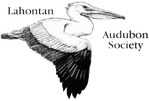|
Excerpt below from The Mystery of the Pinyon Jay: a bird species native to the West has declined dramatically - and we're still trying to figure out why, news article by Alan de Queiroz in the Reno News and Review, February 29, 2024.
Click to read the full story here. In the spring of 2020, I started going for hikes on a part of Peavine Mountain I had hardly ever visited before, just above the Northgate neighborhood in northwest Reno. ... I’ve become attached to the landscape—the shrubby slopes, the scattered outcrops, the pines silhouetted against strange white and orange soils—but mostly, I go there because it’s a great place to find pinyon jays. These birds look like small blue crows and, unlike other jays, usually move around in flocks. I go to follow the jays and, if I’m lucky, to sit in the middle of a flock, experiencing the strange spectacle of these noisy, gregarious birds. “They’re all picking through crevices in the bark for caches (of pine nuts) or probing the ground for caches, and there’s one watching (as a sentry), and they’re rotating through these duties … and it’s really cool to be that close to so many birds,” says Ned Bohman, from the Great Basin Bird Observatory. Every spring, hundreds of birdwatchers drive along predetermined 24.5-mile routes all over the U.S. and in parts of Canada, stopping each half-mile to count every bird they see or hear, making a total of 50 counting points per route. ...The most recent BBS report, covering 1966 through 2022, estimated that the overall number of pinyon jays fell by some 70 percent in that time. ... BBS reports, based on the efforts of thousands of community scientists, were a big part of what put pinyon jays on the radar of conservationists and agency land managers. And, according to John Boone and Ned Bohman (GBBO), community scientists will also be a vital part of the next step in the conservation of this species. “It takes all of us working on this,” said Rose Strickland, the conservation chair for the Lahontan Audubon Society. “Problems are too pervasive; everything is connected, and so we need to be more connected in the way that we approach preserving biodiversity instead of just drawing lines on a map (around protected areas). … It really takes a village.” To learn more about the community science project to map our local Pinyon Jays, please email [email protected]. |
topics
All
Archives
July 2024
|



 RSS Feed
RSS Feed